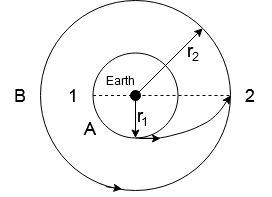
Answer
434.1k+ views
Hint: You can start by calculating the average radius of satellite A when it moves from position 1 to position 2 by using the equation $a = \dfrac{{{r_1} + {r_2}}}{2}$. Then use the $\dfrac{{T_1^2}}{{{T^2}}} = \dfrac{{{a^3}}}{{r_2^3}}$ to find the value of ${T_1}$. Then divide the time period of satellite A by half to reach the solution.
Complete step-by-step answer:
In the given problem we are given two satellites A and B. B is revolving around the earth with a radius ${r_2}$ and A is revolving around the earth with a radius ${r_1}$.
Given ${r_2} = 3{r_1}$
Let the average radius of satellite A (when it goes from position 1 to position 2) be$a$.
We know that a will be the average radius of satellite A, so
$a = \dfrac{{{r_1} + {r_2}}}{2}$
$a = \dfrac{{{r_1} + 3{r_1}}}{2}$
$a = 2{r_1}$
Kepler’s law are very important laws in physics, these laws are used to describe the motion of planets and some other celestial bodies.
Let’s take the time taken of the period of revolution of satellite A in the elliptical path as ${T_1}$
We know by Kepler’s law
$\dfrac{{T_1^2}}{{{T^2}}} = \dfrac{{{a^3}}}{{r_2^3}}$
$\dfrac{{T_1^2}}{{{T^2}}} = \dfrac{{{{(2{r_1})}^3}}}{{{{(3{r_1})}^3}}} = \dfrac{{8r_1^3}}{{27r_1^3}}$
$\dfrac{{T_1^2}}{{{T^2}}} = \dfrac{8}{{27}}$
${T_1} = \sqrt {\dfrac{8}{{27}}} T$
If we see the movement of satellite A from position 1 to position 2 is half of the whole revolution so the time taken by the satellite in moving from position 1 to position 2 is $\dfrac{{{T_1}}}{2} = \dfrac{{\sqrt 2 }}{{3\sqrt 3 }}T$.
Hence, option C is the correct choice.
Note: In the problem there is no specific mention that the objects A and B are satellites. But in these types of questions, it is very important to figure out what the objects are. We figured it out in this case as in this case, the image provided in the problem has earth in the center and satellites revolve around the earth.
Complete step-by-step answer:
In the given problem we are given two satellites A and B. B is revolving around the earth with a radius ${r_2}$ and A is revolving around the earth with a radius ${r_1}$.
Given ${r_2} = 3{r_1}$
Let the average radius of satellite A (when it goes from position 1 to position 2) be$a$.
We know that a will be the average radius of satellite A, so
$a = \dfrac{{{r_1} + {r_2}}}{2}$
$a = \dfrac{{{r_1} + 3{r_1}}}{2}$
$a = 2{r_1}$
Kepler’s law are very important laws in physics, these laws are used to describe the motion of planets and some other celestial bodies.
Let’s take the time taken of the period of revolution of satellite A in the elliptical path as ${T_1}$
We know by Kepler’s law
$\dfrac{{T_1^2}}{{{T^2}}} = \dfrac{{{a^3}}}{{r_2^3}}$
$\dfrac{{T_1^2}}{{{T^2}}} = \dfrac{{{{(2{r_1})}^3}}}{{{{(3{r_1})}^3}}} = \dfrac{{8r_1^3}}{{27r_1^3}}$
$\dfrac{{T_1^2}}{{{T^2}}} = \dfrac{8}{{27}}$
${T_1} = \sqrt {\dfrac{8}{{27}}} T$
If we see the movement of satellite A from position 1 to position 2 is half of the whole revolution so the time taken by the satellite in moving from position 1 to position 2 is $\dfrac{{{T_1}}}{2} = \dfrac{{\sqrt 2 }}{{3\sqrt 3 }}T$.
Hence, option C is the correct choice.
Note: In the problem there is no specific mention that the objects A and B are satellites. But in these types of questions, it is very important to figure out what the objects are. We figured it out in this case as in this case, the image provided in the problem has earth in the center and satellites revolve around the earth.
Recently Updated Pages
How many sigma and pi bonds are present in HCequiv class 11 chemistry CBSE

Mark and label the given geoinformation on the outline class 11 social science CBSE

When people say No pun intended what does that mea class 8 english CBSE

Name the states which share their boundary with Indias class 9 social science CBSE

Give an account of the Northern Plains of India class 9 social science CBSE

Change the following sentences into negative and interrogative class 10 english CBSE

Trending doubts
Fill the blanks with the suitable prepositions 1 The class 9 english CBSE

Difference Between Plant Cell and Animal Cell

Differentiate between homogeneous and heterogeneous class 12 chemistry CBSE

Difference between Prokaryotic cell and Eukaryotic class 11 biology CBSE

Give 10 examples for herbs , shrubs , climbers , creepers

Change the following sentences into negative and interrogative class 10 english CBSE

Write a letter to the principal requesting him to grant class 10 english CBSE

The Equation xxx + 2 is Satisfied when x is Equal to Class 10 Maths

Why is there a time difference of about 5 hours between class 10 social science CBSE




